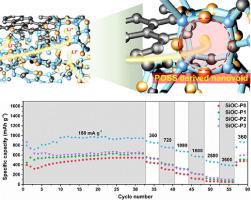Energy Storage Materials ( IF 18.9 ) Pub Date : 2020-11-12 , DOI: 10.1016/j.ensm.2020.11.018 Se Hun Lee , Changyong Park , Kwanghyun Do , Heejoon Ahn

|
Thus far, research on silicon oxycarbide (SiOC, SiOnC4-n (0 ≤ n ≤ 4)) as an anode material for lithium-ion batteries (LIBs) has been focused on the quantity and quality of the carbon domains. This study, however, intends to present a new perspective in order to maximize the utilization of active sites by forming nanovoids in the Si–O–C domain. Structural native nanovoids were formed by introducing PSS-Octakis (dimethylsilyloxy) silsesquioxane (POSS) into the synthesis process of SiOC, and it was then utilized as anode materials of LIBs. Moreover, the effects of POSS on the chemical, structural, and electrochemical properties of SiOC were investigated by varying the content of POSS. It was determined that the addition of POSS could form nanovoids, reduce the free carbon region, decrease the electrical conductivity, and increase the oxygen-rich tetrahedral Si–O–C structure. Despite the reduced electrical conductivity, the porosity formed by the addition of POSS induced high output characteristics by enabling fast ion diffusion to the active SiOC site during the repetitive lithiation/delithiation processes. Furthermore, the nanovoids were found to be capable of improving the structural stability during charge/discharge processes through a buffering effect. Moreover, the increased oxygen-rich tetrahedral Si–O–C structure was able to maximize reversible capacity. Such structural change resulted in a high specific capacity of 980 mAh g−1 at a current density of 180 mA g−1 as well as improved rate capability. A high specific capacity of 412 mAh g−1 was obtained even at a high current density of 3600 mA g−1, and 94% of the initial capacity was maintained after 200 cycles at a current density of 360 mA g−1.
中文翻译:

通过形成天然碳化硅纳米空隙作为锂离子电池的负极材料,最大限度地利用活性位点
到目前为止,关于碳氧化硅(SiOC,SiO n C 4-n(0≤n≤4))作为锂离子电池(LIBs)的负极材料一直集中在碳域的数量和质量上。然而,这项研究旨在提出一个新的观点,以便通过在Si–O–C域中形成纳米空隙来最大程度地利用活性位点。通过在PSC的合成过程中引入PSS-八烷基(二甲基甲硅烷氧基)倍半硅氧烷(POSS)形成结构天然的纳米空隙,然后将其用作LIB的阳极材料。此外,通过改变POSS的含量,研究了POSS对SiOC的化学,结构和电化学性能的影响。已经确定,添加POSS可以形成纳米空隙,减少自由碳区,降低电导率,并增加富氧的四面体Si–O–C结构。尽管降低了电导率,但是通过在重复的锂化/去锂化过程中实现快速的离子扩散到有源SiOC位置,通过添加POSS形成的孔隙率仍具有高输出特性。此外,发现纳米空隙能够通过缓冲作用改善充电/放电过程中的结构稳定性。此外,增加的富氧四面体Si–O–C结构能够使可逆容量最大化。这种结构变化导致980 mAh g的高比容量 发现纳米空隙能够通过缓冲作用改善充电/放电过程中的结构稳定性。此外,增加的富氧四面体Si–O–C结构能够使可逆容量最大化。这种结构变化导致980 mAh g的高比容量 发现纳米空隙能够通过缓冲作用改善充电/放电过程中的结构稳定性。此外,增加的富氧四面体Si–O–C结构能够使可逆容量最大化。这种结构变化导致980 mAh g的高比容量-1在180 mA g -1的电流密度下具有更高的倍率能力。的412毫安g的高比容量-1,甚至在的3600毫安g的高电流密度下得到的-1,和初始容量的94%以360毫安g的电流密度200次循环后维持-1。











































 京公网安备 11010802027423号
京公网安备 11010802027423号